Photo manipulation
Photo manipulation involves transforming or altering a photograph using various methods and techniques to achieve desired results. Some photo manipulations are considered skillful artwork while others are frowned upon as unethical practices, especially when used to deceive the public. Other examples include being used for political propaganda, or to make a product or person look better, or simply for entertainment purposes or harmless pranks.

.jpg)
Depending on the application and intent, some photo manipulations are considered an art form because it involves the creation of unique images and in some instances, signature expressions of art by photographic artists. For example, Ansel Adams employed some of the more common manipulations using darkroom exposure techniques, burning (darkening) and dodging (lightening) a photograph.[1][2] Other examples of photo manipulation include retouching photographs using ink or paint, airbrushing, double exposure, piecing photos or negatives together in the darkroom, scratching instant films, or through the use of software-based manipulation tools applied to digital images. There are a number of software applications available for digital image manipulation, ranging from professional applications to very basic imaging software for casual users.
History
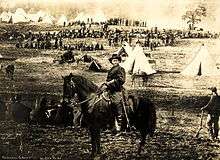
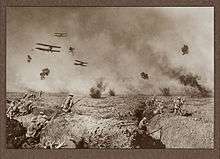

Photo manipulation dates back to some of the earliest photographs captured on glass and tin plates during the 19th century. The practice began not long after the creation of the first photograph (1825) by Joseph Nicéphore Niépce who developed heliography and made the first photographic print from a photoengraved printing plate.[3][4] Traditional photographic prints can be altered using various methods and techniques that involve manipulation directly to the print, such as retouching with ink, paint, airbrushing, or scratching Polaroids during developing (Polaroid art).[5] Negatives can be manipulated while still in the camera using double-exposure techniques, or in the darkroom by piecing photos or negatives together. Some darkroom manipulations involved techniques such as bleaching to artfully lighten or totally wash-out parts of the photograph, or hand coloring for aesthetic purposes or to mimic a fine art painting.[6]
In the early 19th century, photography and the technology that made it possible were rather crude and cumbersome. While the equipment and technology progressed over time, it was not until the late 20th century that photography evolved into the digital realm. At the onset, digital photography was considered by some to be a radical new approach and was initially rejected by photographers because of its substandard quality.[7] The transition from film to digital has been an ongoing process although great strides were made in the early 21st century as a result of innovation that has greatly improved digital image quality while reducing the bulk and weight of cameras and equipment.[8]
Early
An early example of tampering was in the early 1860s, when a photo was altered using the body from a portrait of John C. Calhoun and the head of Lincoln from a famous seated portrait by Mathew Brady – the same portrait which was the basis for the original Lincoln five-dollar bill.[4] Another is exampled in the Library of Congress Prints and Photographs Online Catalogue wherein it exposes a manipulated American Civil War photograph of General Ulysses S. Grant posing horseback in front of his troops at City Point, Virginia.[9] Close observation of the photograph raises questions and brings to light certain details in the photograph that simply do not add up. For example, Grant's head is set at a strange angle to his body, his uniform is of a different time period, and his favorite horse Cincinnati did not have a left hind sock like the horse in the photograph, although his other horse Egypt did have a sock but on a different foot. With further research, three different photographs were discovered that explained the composite using Grant's head from one photograph, the body of Major General Alexander McDowell McCook atop his horse from another photograph, and for the background, a 1864 photograph of Confederate prisoners captured at the Battle of Fisher's Hill.[9] Queen Victoria herself once scratched out her own face on the negative of a family picture made in 1852, as she found herself 'horrid' looking. After this picture, she became more aware of how she looks in pictures and made sure to look a certain way. [10] In the 20th century, digital retouching became available with Quantel computers running Paintbox in professional environments,[11] which, alongside other contemporary packages, were effectively replaced in the market by Adobe Photoshop and other editing software for graphic imaging.
Political and ethical issues
Photo manipulation has been used to deceive or persuade viewers or improve storytelling and self-expression.[12] Often even subtle and discreet changes can have a profound impact on how we interpret or judge a photograph, making it all the more important to know when or if manipulation has occurred. As early as the American Civil War, photographs were published as engravings based on more than one negative.[13] In 1860 a photograph of the politician John Calhoun was manipulated and his body was used in another photograph with the head of the president of the United States, Abraham Lincoln. This photo credits itself as the first manipulated photo. [14]
Joseph Stalin made use of photo retouching for propaganda purposes.[15] On May 5, 1920 his predecessor Vladimir Lenin held a speech for Soviet troops that Leon Trotsky attended. Stalin had Trotsky retouched out of a photograph showing Trotsky in attendance.[16] In a well known case of damnatio memoriae ("condemnation of memory") image manipulation, NKVD leader Nikolai Yezhov, after his execution in 1940, was removed from an official press photo where he was pictured with Stalin, historians subsequently nicknaming him the "Vanishing Commissar").[17] Such censorship of images in the Soviet Union was common. The pioneer among journalists distorting photographic images for news value was Bernarr Macfadden: in the mid-1920s, his "composograph" process involved reenacting real news events with costumed body doubles and then photographing the dramatized scenes—then pasting faces of the real news-personalities (gathered from unrelated photos) onto his staged images. In the 1930s, artist John Heartfield used a type of photo manipulation known as the photomontage to critique Nazi propaganda.
Some ethical theories have been applied to image manipulation. During a panel on the topic of ethics in image manipulation[18] Aude Oliva theorized that categorical shifts are necessary in order for an edited image to be viewed as a manipulation. In Image Act Theory,[19] Carson Reynolds extended speech act theory by applying it to photo editing and image manipulations. In "How to Do Things with Pictures",[20] William J. Mitchell details the long history of photo manipulation and discusses it critically.
Use in journalism
A notable incident of controversial photo manipulation occurred over a photograph that was altered to fit the vertical orientation of a 1982 National Geographic magazine cover. The altered image made two Egyptian pyramids appear closer together than they actually were in the original photograph.[21] The incident triggered a debate about the appropriateness of falsifying an image,[22] and raised questions regarding the magazine's credibility. Shortly after the incident, Tom Kennedy, director of photography for National Geographic stated, "We no longer use that technology to manipulate elements in a photo simply to achieve a more compelling graphic effect. We regarded that afterwards as a mistake, and we wouldn’t repeat that mistake today."[22]
There are other incidents of questionable photo manipulation in journalism. One such incident arose in early 2005 after Martha Stewart was released from prison. Newsweek used a photograph of Stewart's face on the body of a much slimmer woman for their cover, suggesting that Stewart had lost weight while in prison.[23] Speaking about the incident in an interview, Lynn Staley, assistant managing editor at Newsweek said, "The piece that we commissioned was intended to show Martha as she would be, not necessarily as she is." Staley also explained that Newsweek disclosed on page 3 that the cover image of Martha Stewart was a composite.[23]
Image manipulation software has affected the level of trust many viewers once had in the aphorism, the camera never lies.[24] Images may be manipulated for fun, aesthetic reasons, or to improve the appearance of a subject[25] but not all image manipulation is innocuous as evidenced by the Kerry Fonda 2004 election photo controversy. The image in question was a fraudulent composite image of John Kerry taken on June 13, 1971 and Jane Fonda taken in August, 1972 sharing the same platform at a 1971 antiwar rally; the latter of which carried a fake Associated Press credit with the intent to change the public's perspective of reality.[24]
There is a growing body of writings devoted to the ethical use of digital editing in photojournalism. In the United States, for example, the National Press Photographers Association (NPPA) established a Code of Ethics which promotes the accuracy of published images, advising that photographers "do not manipulate images [...] that can mislead viewers or misrepresent subjects."[26] Infringements of the Code are taken very seriously, especially regarding digital alteration of published photographs, as evidenced by a case in which Pulitzer prize-nominated photographer Allan Detrich resigned his post following the revelation that a number of his photographs had been manipulated.[27]
In 2010, a Ukrainian photographer Stepan Rudik, winner of the 3rd prize story in Sports Features, has been disqualified due to violation of the rules of the World Press Photo contest. "After requesting RAW-files of the series from him, it became clear that an element had been removed from one of the original photographs."[28] As of 2015, up to 20%[29] of World Press Photo entries that made it to the penultimate round of the contest were disqualified after they were found to have been manipulated or post-processed with rules violations.[30]
Use in fashion
The photo manipulation industry has often been accused of promoting or inciting a distorted and unrealistic image of self; most specifically in younger people. The world of glamour photography is one specific industry which has been heavily involved with the use of photo manipulation (what many consider to be a concerning element as many people look up to celebrities in search of embodying the 'ideal figure'). Manipulation of a photo to alter a model's appearance can be used to change features such as skin complexion, hair color, body shape, and other features. Many of the alterations to skin involve removing blemishes through the use of the healing tool in Photoshop. Photo editors may also alter the color of hair to remove roots or add shine. Additionally, the model's teeth and eyes may be made to look whiter than they are in reality. Make up and piercings can even be edited into pictures to look as though the model was wearing them when the photo was taken. Through photo editing, the appearance of a model may be drastically changed to mask imperfections.[31]
In an article entitled, Confessions of a Retoucher: how the modeling industry is harming women, a professional retoucher who has worked for mega-fashion brands shares the industry's secrets.[32] Along with fixing imperfections like skin wrinkles and smoothing features, the size of the model is manipulated by either adding or subtracting visible weight. Reverse retouching is just as common as making models skinnier, “distorting the bodies of very thin models to make them appear more robust in a process called reverse retouching. It is almost worse than making someone slimmer because the image claims you can be at an unhealthy weight but still look healthy. In reality, you can't, you have to Photoshop it".[32] Reverse retouching includes eliminating shadows from protruding bones, adding flesh over body parts, color correcting, and removing hair generated for warmth from extreme weight loss. Professionals are saying that if an image is not labeled "not retouched," then the public can assume that photograph has been modified.[33] As the fashion industry continues to use photos that have been manipulated to idealize body types, there is a need for education about how unreal and unhealthy these images are and the negative implications they are promoting.
A photoshop expert, who edited and altered a lot of images for the fashion industry and wants to remain private, says it's normal to photoshop a model thinner and it doesn't matter how thick or thin the model is. They usually edit away up to 10 kilo's. But in the past 20 years, the practice has changed as more celebrities are on social media and the public is now used to how they look. You can't alter their bodies or faces too much as the public will notice that. The retoucher notes that the industry is made for making a lot of dollars in advertising and that the unrealistic ideals cycle will continue as they have to maintain this. [34]
Since 2012, Seventeen Magazine announced they will no longer manipulate photos of their models. 14 year old Julia Bluhm petitioned that the magazine use a minimum of one, unaltered photo in their spread. The petition received over 84,000 signatures. [35]
In social media
Not only are photos being manipulated by professionals for the media, but also with the rise of social media everyone has easy access to edit photos they post online. Countless apps such as Facetune have been created to allow smartphone user tools to modify personal images.[36] These apps allow people to edit virtually every aspect in the photo focusing on the face and body represented. With social media users and the younger generation being exposed to an extreme amount of imagery that has been manipulated the consequences have a negative impact as body ideals are unachievable. Social media has the opportunity to be used as a platform for promoting healthy body image and unedited photos; the need for approval over social media has to be altered in the near future.[37][38]
In advertising
Photo manipulation has been used in advertisement for Tv commercials and magazines to make their products or the person look better and more appealing than how they look in reality. [39] Some tricks that are used with photo manipulation for advertising are: fake grill marks with eye-liner, using white glue instead of milk, or using deodorant to make vegetables look glossy. [40]
Celebrity opposition
Photo manipulation has triggered negative responses from both viewers and celebrities. This has led to celebrities refusing to have their photos retouched in support of the American Medical Association that has decided that "[we] must stop exposing impressionable children and teenagers to advertisements portraying models with body types only attainable with the help of photo editing software"[37] These include Keira Knightley, Brad Pitt, Andy Roddick, Jessica Simpson, Lady Gaga and Zendaya.
Brad Pitt had a photographer, Chuck Close, take photos of him that emphasized all of his flaws. Chuck Close is known for his photos that emphasize all skin flaws of an individual. Pitt did so in an effort to speak out against media using photoshop and manipulating celebrities’ photos in an attempt to hide their flaws. Kate Winslet spoke out against photo manipulation in media after GQ magazine altered her body, making it look unnaturally thin.[41] And 42-year-old Cate Blanchett appeared on the cover of Intelligent Life's 2012 March/April issue, makeup-free and without digital retouching for the first time.[42]
In April 2010, Britney Spears agreed to release "un-airbrushed images of herself next to the digitally altered ones". The fundamental motive behind her move was to "highlight the pressure exerted on women to look perfect".[43] In 2014, Hungarian pop vocalist and songwriter Boggie produced two music videos that achieved global attention for its stance on whitewashing in the beauty industry: the #1 MAHASZ chart hit "Parfüm" (Hungarian version) and "Nouveau Parfum" (French version) from her self-titled album Boggie, which reached two Billboard charts (#3 Jazz Album, #17 World Music Album).[44][45][46] In the videos, the artist is shown singing as she is extensively retouched in real-time, ending with a side-by-side comparison of her natural and manipulated images as the song fades out.
Corporate opposition
Multiple companies have begun taking the initiative to speak out against the use of photo manipulation when advertising their products. Two companies that have done so include Dove and Aerie. Dove created the Dove Self-Esteem Fund and also the Dove Campaign for Real Beauty as a way to try to help build confidence in young women. They want to emphasize what is known as real beauty, or untouched photographs, in the media now.[47] Also, Aerie has started their campaign #AerieREAL. They have a line of undergarments now that goes by that name with the intention of them being for everyone.[48] Also, their advertisements state that the model has not been retouched in any way. They also add in their advertisements that "The real you is sexy."[49]
Also, the American Medical Association has taken a stand against the use of photo manipulation. Dr. McAneny made a statement that altering models to such extremes creates unrealistic expectations in children and teenagers regarding body image. He also said that we should stop altering the models so they are not exposed to body types that can be attained only through the use of editing the photos. The American Medical Associations as a whole adopted a policy to work with advertisers to work on setting up guidelines for advertisements to try to limit how much photoshop is used. The goal of this policy is to limit the amount of unrealistic expectations for body image in advertisement.[50]
Government opposition
Governments are exerting pressure on advertisers, and are starting to ban photos that are too airbrushed and edited. In the United Kingdom the Advertising Standards Authority has banned an advertisement by Lancôme featuring Julia Roberts for being misleading, stating that the flawless skin seen in the photo was too good to be true.[51] The US is also moving in the direction of banning excessive photo manipulation where a CoverGirl model's ad was banned because it had exaggerated effects, leading to a misleading representation of the product.[52]
In 2015, France proceeded to pass a law that battles against the use of unrealistic body images and anorexia in the fashion industry. This includes modeling and photography. The models now have to show they are healthy and have a BMI of over 18 through a note from their doctor. Employers who don't attain to this law will be fined and can serve a jail sentence up to 6 months. When a creator of a photograph does not disclose that the picture is edited or retouched, no matter how small the edit, they also can get a fine or 30% of the costs of what they used to create their ad. [53]
Support
Some editors of magazine companies do not view manipulating their cover models as an issue. In an interview with the editor of the French magazine Marie Claire, she stated that their readers are not idiots and that they can tell when a model has been retouched. Also, some who support photo manipulation in the media state that the altered photographs are not the issue, but that it is the expectations that viewers have that they fail to meet, such as wanting to have the same body as a celebrity on the cover of their favorite magazine.[54]
Opinion polling
Surveys have been done to see how photo manipulation affects society and to see what society thinks of it. One survey was done by a fashion store in the United Kingdom, New Look, and it showed that 90% of the individuals surveyed would prefer seeing a wider variety of body shapes in media. This would involve them wanting to see cover models that are not all thin, but some with more curves than others. The survey also talked about how readers view the use of photo manipulation. One statistic stated that 15% of the readers believed that the cover images are accurate depictions of the model in reality. Also, they found that 33% of women who were surveyed are aiming for a body that is impossible for them to attain.[55]
Dove and People Weekly also did a survey to see how photo manipulation affects the self-esteem of females. In doing this, they found that 80% of the women surveyed felt insecure when seeing photos of celebrities in the media. Of the women surveyed who had lower self-esteem, 70% of them do not believe that their appearance is pretty or stylish enough in comparison to cover models.[56]
Social and cultural implications
The growing popularity of image manipulation has raised concern as to whether it allows for unrealistic images to be portrayed to the public. In her article "On Photography" (1977), Susan Sontag discusses the objectivity, or lack thereof, in photography, concluding that "photographs, which fiddle with the scale of the world, themselves get reduced, blown up, cropped, retouched, doctored and tricked out".[57] A practice widely used in the magazine industry, the use of photo manipulation on an already subjective photograph, creates a constructed reality for the individual and it can become difficult to differentiate fact from fiction. With the potential to alter body image, debate continues as to whether manipulated images, particularly those in magazines, contribute to self-esteem issues in both men and women.
In today's world, photo manipulation has a positive impact by developing the creativity of one's mind or maybe a negative one by removing the art and beauty of capturing something so magnificent and natural or the way it should be. According to The Huffington Post, "Photoshopping and airbrushing, many believe, are now an inherent part of the beauty industry, as are makeup, lighting and styling". In a way, these image alterations are "selling" actual people to the masses to affect responses, reactions, and emotions toward these cultural icons.[58]
Scientific Fraud
Digital fakes
A digital fake refers to a digital video, photo, or audio file that has been altered or manipulated by digital application software. Deepfake videos fall within the category of a digital fake media,[59] but video may be digitally altered without being considered a deepfake. The alterations can be done for entertainment purposes, or more nefarious purposes such as spreading disinformation.[60] The information can be used to conduct malicious attacks, political gains, financial crime, or fraud.[61] It can also be used in pornographic style videos, where an individual's face is placed on the body of a porn star.[62]
"Photoshop" as a verb
The terms "photoshop", "photoshopped" and "photoshopping" are ubiquitous and widely used colloquially and academically when referencing image editing software as it relates to digital manipulation and alteration of photographs.[63][64] The term commonly refers to digital editing of photographs regardless of which software program is used.[65][66][67]
Trademark owner Adobe Systems Incorporated, while flattered over the software's popularity, objected to what they referred to as misuse of their trademarked software, and considered it an infringement on their trademark to use terms such as "photoshopped" or "photoshopping" as a noun or verb, in possessive form or as a slang term.[68] However, Adobe's attempts to prevent "genericization"[69] or "genericide" of the company's trademark[70] failed. Separately, the Free Software Foundation advises against using "photoshop" as a verb because Adobe Photoshop is proprietary software.[71]
In popular culture, the term photoshopping is sometimes associated with montages in the form of visual jokes, such as those published on Fark and in Mad magazine. Images may be propagated memetically via e-mail as humor or passed as actual news in a form of hoax.[72][73] An example of the latter category is "Helicopter Shark", which was widely circulated as a so-called "National Geographic Photo of the Year" and was later revealed to be a hoax.[74]
Gallery
_-2.jpg) Photomontage of 16 photos which have been digitally manipulated in Photoshop to give the impression that it is a real landscape.
Photomontage of 16 photos which have been digitally manipulated in Photoshop to give the impression that it is a real landscape.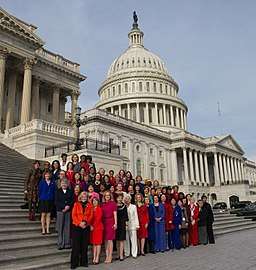
 Photomanipulation
Photomanipulation
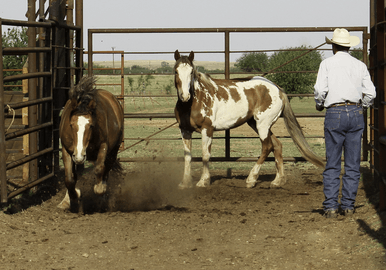 Original photograph of horses being sorted in a corral
Original photograph of horses being sorted in a corral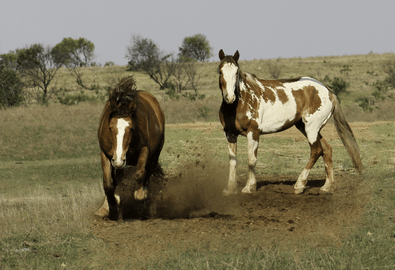 Digitally manipulated composite: horses in original photo are added to a photo of a pasture.
Digitally manipulated composite: horses in original photo are added to a photo of a pasture. Photograph manipulated in Photoshop to give impression it is a painting complete with brush strokes.
Photograph manipulated in Photoshop to give impression it is a painting complete with brush strokes.
See also
- Deepfake
- Derivative work
- Digital photograph restoration
- Error level analysis
- 2006 Lebanon War photographs controversies
- Whitewashing (beauty)
- Cottingley Fairies
- Digital art
- Kerry Fonda 2004 election photo controversy
- Pascal Dangin
- Photoshop contest
- Scientific misconduct#Photo manipulation
- Source criticism
- Straight photography
- SurfSafe, Web browser extension intended to spot images identified as altered
- Tobacco bowdlerization
- Truth claim (photography)
- Visual arts
References
- Jack Dziamba (February 27, 2013). "Ansel Adams, and Photography Before Photoshop".
- Mia Fineman (November 29, 2012). "Artbeat". PBS Newshour (Interview). Interviewed by Tom Legro. South Florida: WPBT2. Retrieved January 30, 2016.
- "World's oldest photo sold to library". BBC News. March 21, 2002. Retrieved November 17, 2011.
The image of an engraving depicting a man leading a horse was made in 1825 by Nicephore Niepce, who invented a technique known as heliogravure.
- Farid, Hany. "Photo Tampering Throughout History" (PDF). Archived from the original on September 8, 2015.
- Klaus Wolfer (ed.). "How to manipulate SX-70?". Polaroid SX-70 Art. Skylab Portfolio. Retrieved February 2, 2016.
- Lynne Warren (2006). Encyclopedia of Twentieth-Century Photography, 3-Volume Set. Routledge. p. 1007. ISBN 9781135205362.
- Peres, Michael (2007). The Focal Encyclopedia of Photography, Fourth Edition. Focal Press; 4 edition. p. Preface, 24. ISBN 978-0-240-80740-9. Retrieved January 30, 2016.
- Reichmann, Michael (2006). "Making The Transition From Film To Digital" (PDF). Adobe Systems Incorporated.
- "Civil War Glass Negatives and Related Prints – Solving a Civil War Photograph Mystery". Library of Congress. Retrieved January 30, 2016.
- Tramz, Mia. "Magnificent Obsession: How Queen Victoria Influenced Photography". Time. Retrieved April 4, 2020.
- Fabio Sasso (July 2011). Abduzeedo Inspiration Guide for Designers. Pearson Education. p. 124. ISBN 9780132684729.
- Rotman, Brian (2008). Becoming Beside Ourselves: The Alphabet, Ghosts, and Distributed Human Being. Duke University Press. pp. 96–97. ISBN 978-0822341833.
- Peter E. Palmquist, Thomas R. Kailbourn (2005). Pioneer Photographers from the Mississippi to the Continental Divide: A Biographical Dictionary, 1839-1865. Stanford University Press. p. 55. ISBN 978-0804740579.
- Sharma, Jitendra & Rohita (2017). "Analysis of Key Photo Manipulation Cases and their Impact on Photography" (PDF).
- King, D. (1997). The Commissar Vanishes: the falsification of photographs and art in Stalin's Russia. New York: Metropolitan Books. ISBN 0-8050-5294-1.
- Ammann, Daniel (2009). The King of Oil: The Secret Lives of Marc Rich. Macmillan. p. 228. ISBN 978-1429986854.
- The Newseum (September 1, 1999). ""The Commissar Vanishes" in The Vanishing Commissar". Retrieved September 30, 2012.
- Carlson, Kathryn; DeLevie, Brian; Oliva, Aude (2006). "Ethics in image manipulation". ACM SIGGRAPH 2006. International Conference on Computer Graphics and Interactive Techniques. ACM. doi:10.1145/1179171.1179176. ISBN 1-59593-364-6.
- Reynolds, C. J. (July 12–14, 2007). Image Act Theory (PDF). Seventh International Conference of Computer Ethics. Archived from the original (PDF) on May 28, 2008.
- Mitchell, William John (1994). "How to Do Things with Pictures". The Reconfigured Eye: Visual Truth in the Post-Photographic Era. MIT Press.
- Fred Ritchin (November 4, 1984). "Photography's New Bag Of Tricks". The New York Times Company. Retrieved January 6, 2016.
- "National Geographic — Altered Images". Bronx Documentary Center. Retrieved January 6, 2016.
- Jonathan D. Glater (March 3, 2005). "Martha Stewart Gets New Body In Newsweek". New York Times. Retrieved January 6, 2015.
- Katie Hefner (March 11, 2004). "The Camera Never Lies, But The Software Can". The New York Times Company.
- Kitchin, Rob (2011). "6". Code/Space: Software and Everyday Life. The MIT Press. p. 120. ISBN 978-0-262-04248-2.
- "NPPA Code of Ethics". National Press Photographers Association. January 28, 2017.
- Lang, Daryl (April 15, 2007). "Blade Editor: Detrich Submitted 79 Altered Photos This Year". Photo District News.
- "Announcement of disqualification". World Press Photo. Retrieved January 22, 2016.
- "World Press Photo Organizer: 20% of Finalists Disqualified". TIME.com. Retrieved January 22, 2016.
- "What counts as manipulation?". World Press Photo. Retrieved January 22, 2016.
- Metzmacher, Dirk. "Smashing Magazine." Smashing Magazine. N.p., n.d. Web. April 16, 2014.
- Cage, Carolyn (October 6, 2017). "Confessions of a retoucher: how the modelling industry is harming women". The Sydney Morning Herald. Retrieved October 30, 2018.
- "Here's how retouched photos impact our mental health". Business Insider. Retrieved October 30, 2018.
- Clun, Rachel (September 24, 2014). "Photoshop shock: Insider reveals fashion industry image editing practices". The Sydney Morning Herald. Retrieved April 4, 2020.
- Amanda Oliver. "4 Companies That Refuse to Photoshop—And Why That Matters For All Genders". Groundswell. Retrieved April 4, 2020.
- Media, Caroline Knorr, Common Sense. "How girls use social media to build up, break down self-image". CNN. Retrieved October 30, 2018.
- "Photoshop contributes to unrealistic expectations of appropriate body image: AMA". NY Daily News. Retrieved April 25, 2016.
- Solon, Olivia (March 9, 2018). "FaceTune is conquering Instagram – but does it take airbrushing too far?". The Guardian. ISSN 0261-3077. Retrieved April 4, 2020.
- "Digital Media Literacy: The Problem with Photo Manipulation". GCFGlobal.org. Retrieved April 4, 2020.
- "Food photography and manipulation in advertising: Why do we accept knowingly being lied to?". Truly Deeply - Brand Agency Melbourne. November 19, 2015. Retrieved April 4, 2020.
- "Keep It Real Challenge: Photoshop's Impact on Body Image". info.umkc.edu. June 29, 2012. Retrieved April 19, 2015.
- Roberts, Soraya. "Cate Blanchett goes without digital enhancement on the cover of Intelligent Life". The Juice. Retrieved March 22, 2012.
- Claire, Marie (April 14, 2010). "SEE PICS! Before & after: Britney Spears' airbrushed Candie's ads". Marie Claire. Retrieved April 23, 2020.
- "Boggie Photoshop music video: Singer uses Nouveau Parfum promo to show how digital trickery can transform you | Metro News". metro.co.uk. January 22, 2014. Retrieved February 1, 2014.
- "A Mahasz Stream Top 40 listájának első helyezettjei". Wikipédia (in Hungarian). Retrieved July 7, 2019.
- "It's Boggie for Hungary!". Eurovision. February 28, 2015. Retrieved July 7, 2019.
- "The Evolution Video – Dove Self Esteem Project". selfesteem.dove.us. June 2, 2013. Retrieved May 1, 2015.
- "Aerie for American Eagle". Archived from the original on January 29, 2017. Retrieved May 1, 2015.
- Krupnick, Ellie (January 17, 2014). "Aerie's Unretouched Ads 'Challenge Supermodel Standards' For Young Women". The Huffington Post. Retrieved May 1, 2015.
- "AMA Adopts New Policies at Annual Meeting". ama-assn.org. June 21, 2011. Retrieved April 19, 2015.
- Zhang, Michael. "Julia Roberts Makeup Ads Banned in UK for Too Much Photoshop". PetaPixel. Retrieved July 27, 2011.
- Anthony, Sebastian. "US watchdog bans photoshopping in cosmetics ads". Retrieved December 16, 2011.
- "France Bans Too-Thin Fashion Models, Demands That Photoshopping Be Labeled". petapixel.com. Retrieved April 4, 2020.
- "In Defense of Photoshop: Why Retouching Isn't As Evil As Everyone Thinks". The Cut. August 29, 2010. Retrieved April 19, 2015.
- "Women Need Further Educating Into Extent of Digital Manipulation of Mo". prweb.com. November 26, 2013. Retrieved April 19, 2015.
- Matlins, Seth; ContributorCo-founder; Better, Feel More (August 22, 2011). "Why Beauty Ads Should Be Legislated". HuffPost. Retrieved April 23, 2020.
- Sontag, Susan (1977). On Photography. p. 4.
- L. Boutwell, Allison. "Photoshop: A Positive and Negative Innovation".
- Joseph, Rebecca. "What are deepfakes?". Global News.
- Bellemare, Andrea. "CBC News Technology Fake News and Misinformation". Canadian Broadcast Corporation.
- Bogart, Nicole (September 10, 2019). "How deepfakes could impact the 2019 Canadian election". Federal Election 2019. Retrieved April 30, 2020.
- Sample, Ian (January 13, 2020). "What are deepfakes – and how can you spot them?". The Guardian. ISSN 0261-3077. Retrieved April 4, 2020.
- Blatner, David (August 1, 2000). "Photoshop: It's Not Just a Program Anymore". Macworld. Archived from the original on March 15, 2005.
- "Photoshop Essentials". Graphic Design Portfolio-Builder: Adobe Photoshop and Adobe Illustrator Projects. Peachpit Press. August 15, 2005. ISBN 978-0-321-33658-3.
- Rodriguez, Edward (2008). Computer Graphic Artist. Netlibrary. p. 163. ISBN 978-81-89940-42-3.
The term photoshopping is a neologism, meaning "editing an image", regardless of the program used.
- Geelan, David (2006). Undead Theories: Constructivism, Eclecticism And Research in Education. Sense Publisher. p. 146. ISBN 90-77874-31-3.
And with digital photography, there is also the possibility of photoshopping – digitally editing the representation to make it more aesthetically pleasing, or to change decisions about framing.
- Laurence M. Deutsch (2001). Medical Records for Attorneys. ALI-ABA. ISBN 9780831808174.
- "Use Of The Photoshop Trademark" (PDF) (Press release). Adobe Systems Incorporated. Retrieved February 2, 2016.
- Katharine Trendacosta (August 26, 2015). "Here Is Adobe's Attempt to Stop People From Using the Term "Photoshop" All Willy-Nilly". Gawker Media. Retrieved February 2, 2016.
- John Dwight Ingram (2004). "The Genericide of Trademarks" (PDF). Buffalo Intellectual Property Law Journal. State University of New York. 2 (2). Archived from the original (PDF) on February 2, 2017. Retrieved February 2, 2016.
- Stallman, Richard (April 21, 2018). "Words to Avoid (or Use with Care) Because They Are Loaded or Confusing: 'Photoshop'". GNU Project. Free Software Foundation. Archived from the original on May 28, 2018. Retrieved May 28, 2018.
Please avoid using the term 'photoshop' as a verb, meaning any kind of photo manipulation or image editing in general. Photoshop is just the name of one particular image editing program, which should be avoided since it is proprietary. There are plenty of free programs for editing images, such as the GIMP [link in original].
- Jenn Shreve (November 19, 2001). "Photoshop: It's All the Rage". Wired Magazine.
- Corrie Pikul (July 1, 2004). "The Photoshopping of the President". Salon.com Arts & Entertainment. Archived from the original on March 10, 2008.
- Danielson, Stentor; Braun, David (March 8, 2005). "Shark "Photo of the Year" Is E-Mail Hoax". National Geographic News. Retrieved May 20, 2006.
- ABC News (January 4, 2013). "Pelosi Defends Altered Photo of Congresswomen". Retrieved January 4, 2013.
- Washington Post (January 4, 2013). "House Democratic leader Nancy Pelosi defends altered photo of women House members". Retrieved January 4, 2013.
- Salon.com (January 4, 2013). "Pelosi defends altered photo of congresswomen". Retrieved January 4, 2013.
- Huffington Post (January 4, 2013). "Nancy Pelosi Defends Altered Photo Of Congresswomen (PHOTO)". Archived from the original on January 7, 2013. Retrieved January 4, 2013.
- WSET News (ABC TV-13) (January 4, 2013). "Pelosi defends altered photo of congresswomen". Retrieved January 4, 2013.
External links
| Look up photoshop in Wiktionary, the free dictionary. |
| Wikimedia Commons has media related to Photo manipulation. |
- Digital Tampering in the Media, Politics, and Law – a collection of digitally manipulated photos of political interest
- Hoax Photo Gallery – more manipulated photos
- Erased figures in Kagemni's tomb — discusses political image manipulation with an example from Ancient Egypt
